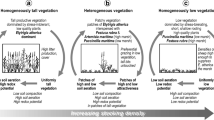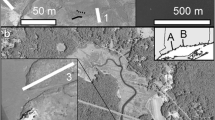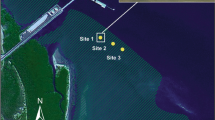Abstract
Grazing by livestock is used as a management tool to prevent the dominance of a single tall-growing specises during succession on European salt marshes. The effects of natural small herbivores are often neglected by managers. Long-term exclosure experiments on the island of Schiermonnikoog show that hares retard vegetation succession at the early stages of salt-marsh development. In the present study we test whether we can scale-up these exclosure studies to a whole salt-marsh system. We compared 30 years of undisturbed vegetation succession at the Wadden Sea islands of Schiermonnikoog, Rottumerplaat (both The Netherlands) and Mellum (Germany). Salt-marsh development started at all sites in the early 1970s. Hares have been present only on Schiermonnikoog. At each site an area was selected covering a gradient from high to low salt marsh. Surface elevation and clay thickness were measured and a vegetation map was made on the three islands. The areas showed similar clay thickness at low surface elevation, indicating similar sedimentation ratesand hence nitrogen inputs. Rottumerplaat and Mellum showed a higher dominance of the late successional speciesAtriplex portulacoides in the low marsh andElymus athericus in the high marsh compared to Schiermonnikoog. Typical mid-successional, important food plant species for hares and geese had a higher abundance at Schiermonnikoog. Patterns of vegetation development in the absence of hares followed the observed patterns in the smallscale exclosure experiments at Schiermonnikoog. Without hare grazing, vegetation succession proceeds more rapidly and leads to the dominance of tall-growing species in earlier stages of succession. The present study shows that next to large herbivores, small herbivores potentially have largescale effects on salt-marsh vegetation succession during the early successional stages.
Similar content being viewed by others
References
Abrahamse, J., Joenje, W. & van Leeuwen-Seelt, N. 1977.Waddenzee: natuurgebied van Nederland, Duitsland en Denemarken. Landelijke vereniging tot behoud van de Waddenzee, Vereniging tot behoud van natuurmonumenten in Nederland, Harlingen, ’s-graveland, NL.
Andresen, H., Bakker, J.P., Brongers, M., Heydemann, B. & Irmler, U. 1990. Long-term changes of salt marsh communities by cattle grazing.Vegetatio 89: 137–148.
Bakker, J.P., de Leeuw, J., Dijkema, K.S., Leendertse, P.C., Prins, H.H.T. & Rozema, J. 1993. Salt marshes along the coast of the Netherlands.Hydrobiologia 265: 73–95.
Bakker, J.P., Bos, D. & de Vries, Y. 2003. To graze or not to graze, that is the question. In: Essink, K., van Leeuwe, M., Kellerman, A. & Wolff, W.J. (eds.)Proceedings 10th International Scientific Wadden Symposium, pp. 67–87 Ministry of Agriculture, Nature Management and Fisheries, Den Haag, NL.
Bockelmann, A.-C., Bakker, J.P., Neuhaus, R. & Lage, J. 2002. The relation between vegetation zonation, elevation and inundation frequency in a Wadden Sea salt marsh.Aquat. Bot. 2002: 211–221.
Bortolus, A. & Iribarne, O. 1999. Effects of the SW Atlantic burrowing crabChasmagnathus granulata on aSpartina salt marsh.Mar. Ecol. Progr. Ser. 178: 79–88.
Bos, D., Bakker, J.P., de Vries, Y. & van Lieshout, S. 2002. Long-term vegetation changes in experimentally grazed and ungrazed back-barrier marshes in the Wadden Sea.Appl. Veg. Sci. 5: 45–54.
Bouwsema, P. 1983.Rottumerplaat: overzicht van de doelstellingen, ontwikkelingen en resultaten 1950–1980. Report Rijkswaterstaat, dienstkring Baflo, Den Haag, NL.
Connors, L.M., Kiviat, E., Groffman, P.M. & Ostfeld, R.S. 2000. Muskrat (Ondatra zibethicus) disturbance to vegetation and potential net nitrogen mineralization and nitrification rates in a fresh water tidal marsh.Am. Midl. Nat. 143: 53–63.
de Jong, D.J., Dijkema, K.S., Bossinade, J.H. & Janssen, J.A.M. 1988.Salt97, een classificatiepro gramma voor kweldervegetaties. Rijkswaterstaat (RIKZ, Diectie Noord Nederland, Meetkundige Dienst) & IBN-DLO, Wageningen, NL.
de Meulmeester, T. & Janssen, J. 1997. Ontwikkelingen in flora en vegetatie van Rottumeroog en Rottumerpla at sinds 1916.Levende Nat. 97: 55–61.
Hartung, W. 1987. Mellum-Ausblick auf seine Entwicklung und seine Bedeutung fur Naturschutz, Forschung und Lehre. In: Gerdes, G., Krumbein, W.E. & Reineck, H.-E. (eds.)Mellum, Portrait einer Insel, pp. 321–328. Verlag Waldemar Kramer, Franfurt, DE.
Horsthuis, M.A.P., Janssen, J.A.M. & de Meulmeester, A.M. 1996. Een beschrijving op landschapsecologische grondslag. De vegetatie van Rottumeroog en Rottumerplaat.Stratiotes 13: 7–29.
Huizing, J.J., van den Bergs, J., Hageman, G., de Jonge, T. & Hut, H. 1996.Rottum natuurlijk… Een evaluatie van monitoringsgegevens en beheer. Rijkswaterstaat Directie Noord Nederland, Staatsbosbeheer, Groningen, NL.
Joenje, W. 1985. The significance of waterfowl grazing in the primary vegetation succession on embanked sandflats.Vegetatio 62: 399–406.
Kiehl, K., Eischeid, I., Gettner, S. & Walter, J. 1996. Impact of different sheep grazing intensities on salt marsh vegetation in northern Germany.J. Veg. Sci. 7: 99–106.
Kiehl, K., Esselink, P. & Bakker, J.P. 1997. Nutrient limitation and plant species composition in temperate salt marshes.Oecologia 111: 325–330.
Kiffe, K. 1989. Influence on vegetation of grazing by wild rabbits as seen in the bentgrass turf of East Frisian Island dunes West Germany.Tuexenia 9: 283–292.
Kuhbier, H. 1987. Die Entwicklung des Gruenlandes auf Mellum. In: Gerdes, G., Krumbein, W. E. & Reineck, H.-E. (eds.)Mellum, Portrait einer Insel, pp. 234–262. Verlag Waldemar Kramer, Frankfurt, DE.
Leendertse, P.C., Roozen, A.J.M. & Rozema, J. 1997. Longterm changes (1953–1990) in the salt marsh vegetation at the Boschplaat on Terschelling in relation to sedimentation and flooding.Plant Ecol. 132: 58–64.
Meyer, M. & Michaeli, H. 1980. Das Makrobenthos des westlichen ‘Hohen Weges’.Jahresber. 1979 Forschungs Stelle fur Insel und Kuestenschutz, Norderney 31: 91–155.
Mitchel-Jones, A.J. 1999.The atlas of European mammals. Academic Press, London, UK.
Olff, H., de Leeuw, J., Bakker, J.P., Platerink, R.J., van Wijnen, H.J. & de Munck, W. 1997. Vegetation succession and herbivory in a salt marsh: Changes induced by sea level rise and silt deposition along an elevational gradient.J. Ecol. 85: 799–814.
Palomares, F. & Delibes, M. 1997. Predation upon European rabbits and their use of open and closed patches in Mediterranean habitats.Oikos 80: 407–410.
Prins, H.H.T. & Ydenberg, R.C. 1985. Vegetation growth and the seasonal habitat shift of the barnacle goose (Branta leucopsis).Oecologia 66: 122–125.
Prop, J. & Deerenberg, C. 1991. Spring staging in Brent geese (Branta bernicla): feeding constraints and the impact of diet on the accumulation of body reserves.Oecologia 87: 19–28.
Roozen, A.J.M. & Westhoff, V. 1985. A long-term study on salt marsh succession using permanent plots.Vegetatio 61: 23–32.
Rowcliffe, J.M., Watkinson, A.R. & Sutherland, W.J. 1998. Aggregative responses of brent geese on salt marsh and their impact on plant community dynamics.Oecologia 114: 417–426.
Silliman, B.R. & Zieman, J.C. 2001. Top-down control ofSpartina alterniflora production by periwinkle grazing in a Virginia salt marsh.Ecology 82: 2830–2845.
Srivastava, D.S. & Jefferies, R.L. 1996. A positive feedback: Herbivory, plant growth, salinity, and the desertification of an Arctic salt-marsh.J. Ecol. 84: 31–42.
Stahl, J., Bos, D. & Loonen, M.J.J.E. 2002. Foraging along a salinity gradient: The effect of tidal inundation on site choice by Dark-bellied Brent GeeseBranta bernicla and Barnacle GeeseB. leucopsis.Ardea 90: 201–212.
ten Harkel, M.J. & van der Meulen, F. 1996. Impact of grazing and atmospheric nitrogen deposition on the vegetation of dry coastal dune grasslands.J. Veg. Sci. 7: 445–452.
van der Meijden, R., Weeda, E.J., Holverda, W.J. & Hovenkamp, P.H. 1990.Heukels’ Flora van Nederland. Wolters-Noordhoff, Groningen, NL.
van der Wal, R., Kunst, P. & Drent, R.H. 1998. Interactions between hare and brent goose in a salt marsh system: Evidence for food competition?Oecologia 117: 227–234.
van der Wal, R., van Lieshout, S., Bos, D. & Drent, R.H. 2000a. Are spring staging brent geese evicted by vegetation succession?Ecography 23: 60–69.
van der Wal, R., van Wijnen, H., van Wieren, S., Beucher, O. & Bos, D. 2000b. On facilitation between herbivores: How Brent Geese profit from brown hares.Ecology 81: 969–980.
van Laar, V. 1983. The Wadden Sea as a zoogeographical barrier to the dispersion ofterrestrial mammals. In: Smit, C., den Hollander, J., van Wingerden W.K.R.E. & Wolff, W.J. (eds.)Terrestrial and freshwater fauna of the Wadden Sea area, pp. 231–266. Balkema, Rotterdam, NL.
van Wijnen, H.J. & Bakker, J.P. 1997. Nitrogen accumulation and plant species replacement in three salt-marsh systems in the Wadden Sea.J. Coastal Conserv. 3: 19–26.
Zacheis, A., Hupp, J.W. & Ruess, R.W. 2001. Effects of migratory geese on plant communities of an Alaskan salt marsh.J. Ecol. 89: 57–71.
Zeevalking, H.J. & Fresco, L.F.M. 1977. Rabbit grazing and species diversity in a dune area.Vegetatio 35: 193–196.
Author information
Authors and Affiliations
Corresponding author
Rights and permissions
About this article
Cite this article
Kuijper, D.P.J., Bakker, J.P. Large-scale effects of a small herbivore on salt-marsh vegetation succession—A comparative study on three Wadden Sea islands. J Coast Conserv 9, 179–188 (2003). https://doi.org/10.1652/1400-0350(2003)009[0179:LEOASH]2.0.CO;2
Received:
Revised:
Accepted:
Published:
Issue Date:
DOI: https://doi.org/10.1652/1400-0350(2003)009[0179:LEOASH]2.0.CO;2




